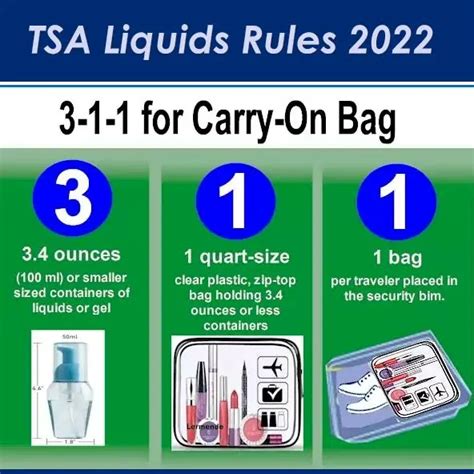TSA Liquid Requirements Explained

Introduction to TSA Liquid Requirements
When traveling by air, it’s essential to understand the Transportation Security Administration’s (TSA) liquid requirements to avoid any issues during security checks. The TSA has specific rules regarding the transportation of liquids, gels, and aerosols in carry-on bags to ensure the safety of all passengers. In this article, we will delve into the details of the TSA’s liquid requirements, explaining what is allowed and what is not.
Understanding the 3-1-1 Liquids Rule
The TSA’s liquids rule is often referred to as the 3-1-1 rule. This rule states that:
- Liquids, gels, and aerosols must be in 3.4-ounce (100 milliliter) or smaller containers.
- These containers must be placed in a 1-quart (1-liter) sized clear, zip-top bag.
- Only 1 zip-top bag is allowed per passenger.
Examples of Liquids, Gels, and Aerosols
To clarify what falls under the category of liquids, gels, and aerosols, here are some examples:
- Liquids: water, juice, soda, and other beverages.
- Gels: hair gel, shower gel, and jam.
- Aerosols: spray deodorant, spray sunscreen, and hairspray.
Exceptions to the 3-1-1 Rule
There are some exceptions to the TSA’s 3-1-1 rule:
- MEDICATIONS: Prescription medications, baby formula, and breast milk are exempt from the 3-1-1 rule. However, it’s recommended to declare these items at security checkpoints and be prepared to provide proof of their medical necessity.
- FOOD AND BREAST MILK FOR INFANTS: Reasonable quantities of baby formula, breast milk, and juice for infants or toddlers are allowed, but you may be subject to additional screening.
Preparing for Security Checkpoints
To make your security screening process smoother:
- Place your 1-quart zip-top bag with liquids, gels, and aerosols in an easily accessible part of your carry-on bag.
- Be prepared to remove your zip-top bag from your carry-on and place it in a bin for X-ray screening.
- Wear easy-to-remove shoes, avoid wearing anything with metal, and consider applying for TSA Precheck for expedited screening.
📝 Note: Always check the TSA's official website for the most up-to-date information on travel restrictions and requirements, as they can change frequently.
Non-Compliant Items
Items that do not comply with the 3-1-1 rule will need to be:
- Checked in your luggage.
- Disposed of before passing through security checkpoints.
International Travel Considerations
For international travel, be aware that:
- Some countries have stricter rules regarding liquids, gels, and aerosols.
- It’s essential to check with your airline and the destination country’s regulations before your trip.
Embedding the 3-1-1 Rule into Your Travel Routine
 To ensure a hassle-free travel experience, make the 3-1-1 rule a part of your packing routine. Remember, being prepared and informed is key to navigating airport security checkpoints efficiently.
To ensure a hassle-free travel experience, make the 3-1-1 rule a part of your packing routine. Remember, being prepared and informed is key to navigating airport security checkpoints efficiently.
Final Travel Tips
Before your next flight:
- Plan ahead and pack wisely, considering the TSA’s liquid requirements.
- Stay informed about any updates to the TSA’s rules and regulations.
- Consider the benefits of TSA Precheck or other trusted traveler programs for a smoother security experience.
In summary, the TSA’s liquid requirements are in place to ensure the safety of all air travelers. By understanding and complying with these rules, you can help maintain a secure and efficient travel process. Whether you’re a seasoned traveler or embarking on your first flight, being aware of what you can and cannot bring in your carry-on bag will make your journey smoother and less stressful.
What is the TSA’s 3-1-1 liquids rule?
+
The TSA’s 3-1-1 rule states that liquids, gels, and aerosols must be in 3.4-ounce (100 milliliter) or smaller containers, placed in a 1-quart (1-liter) sized clear, zip-top bag, with only 1 zip-top bag allowed per passenger.
Are there any exceptions to the 3-1-1 rule?
+
Yes, there are exceptions for medications, baby formula, and breast milk. These items are exempt from the 3-1-1 rule but may require additional screening and proof of medical necessity.
How can I prepare for security checkpoints?
+
To prepare, place your 1-quart zip-top bag with liquids, gels, and aerosols in an easily accessible part of your carry-on, be prepared to remove it for X-ray screening, and consider applying for TSA Precheck for expedited screening.